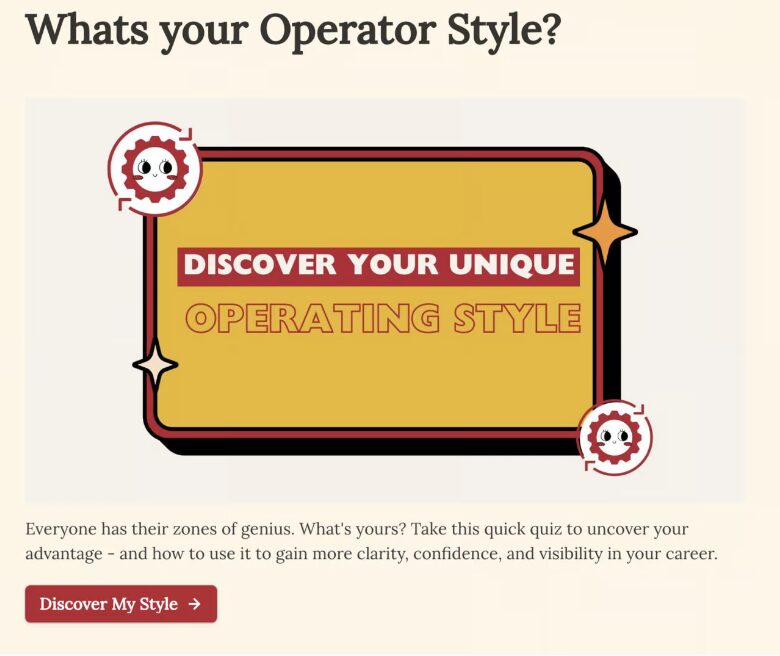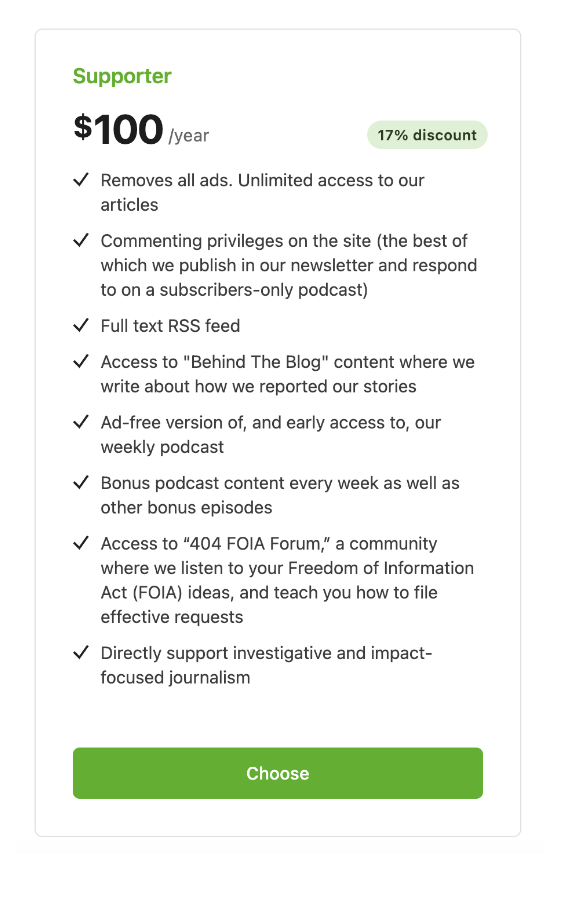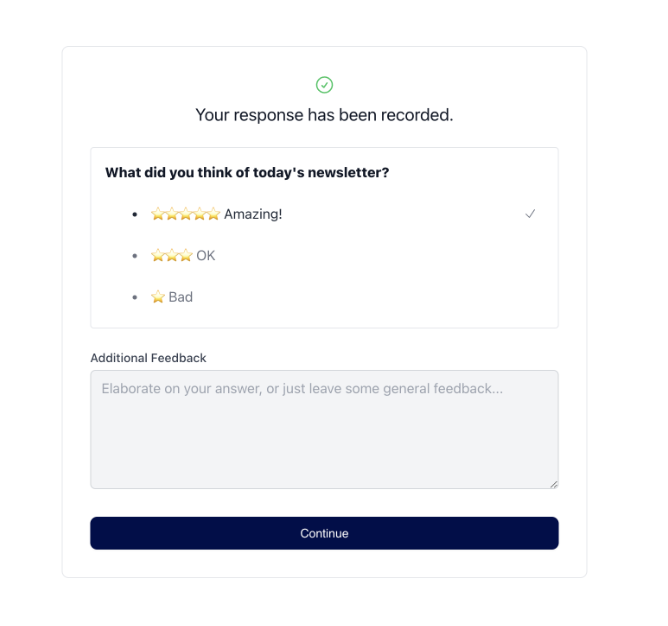5 ways to drive more actionable audience feedback
Last updated: January 3, 2025

Surveys give you audience feedback straight from the source, so they’re your best way to learn about your audience and create experiences that they’ll love.
But sticking to a year-end survey will only get you so far these days. To stay on top of your audience’s needs, you need to drive a higher quantity and quality of feedback year-round. And you need to make it easier for readers to tell you what they’re really thinking.
Collect more first-party data, get more actionable audience feedback and (most importantly) make your subscribers happy with these best practices.
Create a consistent feedback loop by running smaller surveys in your newsletters, articles, etc.
It’s standard to run year-end surveys focused on general customer satisfaction. There’s a time and a place for that. But limiting yourself to a generalized year-end survey keeps your team from getting the granular insights they need to improve specific products.
Streamline your tech stack: Boost efficiency, unify data & retain talent! Get expert tips now
Or they won’t be able to remember your content from eight months ago, and you’ll miss opportunities to get feedback.
Another factor: It’s easy to tune out year-end surveys. (According to our quarterly email engagement reports, survey and research emails get click rates between 0.6% and 0.8%, the lowest among our five email types.)
So if you’re not getting enough survey responses, it’s worth expanding to other survey types. That includes:
Conduct surveys at critical points of the purchase journey, like upon sign-up, after a customer support conversation, or upon renewal. This way, you can track subscriber satisfaction throughout the lifecycle and pinpoint specific areas of improvement.
Use polls in your webinars and online events: Use polls within webinars to generate more useful feedback about your audience. Make the most of your polls with these best practices.
- Pick webinar topics that will yield useful audience data: Webinars are longer and more interactive than other content types, so they lend themselves to more in-depth survey questions. Asking the right questions will help your content team produce more relevant resources with less effort. So ask your editorial team what they want to know about your audience, then draft webinars that’ll help you address those questions in a poll.
- Don’t make your surveys mandatory: Many webinar providers will let you require audience members to answer the poll question in order to see the rest of the session. Don’t do it! You run the risk of having audience members provide fake answers just to close the pop-up, which will distort your data and render the exercise worthless.
- Don’t ask too many questions: This also increases the odds of low-quality responses or worse, early departures. Aim to ask one question every 10-15 minutes of the session. This gives you a decent amount of data without overtaxing your audience.
Incorporate mini-surveys in your newsletters and articles to gauge audience sentiment and interest in specific topics. Many publishers will conduct content surveys asking audience members what they want to see. But a) you can only run those longer surveys so many times and b) they don’t always tell you how your audience feels about more specific topics.
In addition to those broad content surveys, include a one-question survey in an email or article. You could ask audiences how they liked the content, their level of knowledge about the topic, or other follow-up questions related to the topic.
Since they’re baked into the content itself, your audience is more likely to respond — and the answers will lend more context to your open, click and click-through rates.
Make self-disclosure more fun.
Your onboarding survey is your best chance to learn more about your audience. And if you’re doing your job right, this can be a mutually beneficial transaction. You learn about your audience member’s needs, interests and knowledge levels, and that information helps you better individualize your offering to their needs.
But when they’re just signing up, your audience doesn’t know whether you’ll fulfill your end of the bargain yet. So your onboarding survey, well-intentioned as it might be, still feels like homework to them. And surprise, surprise, your survey gets a 2% completion rate.
So how can you tip the scales in your audience’s favor?.
Make the survey itself fun on its own. An example we like comes from Rameel Sheikh, the creator of Bottleneck, a newsletter for COOs and business operations professionals.
His welcome survey is a 24-question Buzzfeed-style quiz titled “What’s your operator style?” This includes a mix of light A-B questions about project management, a few deeper questions on pain points, and some demographics.
With a light tone, pleasant design, and audience-first approach, the survey gives real value to the reader while still giving Sheikh the information he needs to customize content to each reader.

In a recent interview with Creator Spotlight, he claimed his onboarding survey had gotten a 75% open rate and a 23% click-through rate to the quiz — around 1,300 people filled it out.
And as Francis Zierer pointed out in her profile of Singh, publishers can replicate this strategy themselves. To do this, she suggests:
- “Identify, based on your audience’s interests, what would flatter them
- Create a few bespoke, tongue-in-cheek personality archetypes based on that
- Build a quiz based on those archetypes; add additional personal disclosure questions”
PS: This is why we integrate with CredSpark, which you can use to build interactive polls, surveys and quizzes — and act on the results more quickly.
When the integration’s active, each form submission flows to your Omeda database. When someone completes a CredSpark form on your website, it’s recorded in their Omeda profile in real time — no uploads or transfers required. They’re also added to any new segments that they qualify for based on those responses.
This way, your email, content and audience team can see who’s responding to your content — and reach out with more personalized offers and resources — right away.
Start a dialogue with open-ended comment sections or a separate Discord/Slack community.
So consider implementing comment sections at the end of your articles or creating an open discussion forum on Discord or Slack.
Surveys and polls produce valuable insights. But they address questions that you already have in mind. But often, we don’t know what we don’t know. Letting your audience tell you what you think, in their own words, can alert you to potential issues before it starts impacting your audience health. So consider implementing comment sections at the end of your articles or creating an open discussion forum on Discord or Slack.
Moderating these platforms takes more work. But especially if you’re running an industry-focused publication, it can pay off in the form of richer feedback, longer and more productive conversations between members, and higher engagement.
(And they’re increasingly helping drive revenue. We’re seeing more publications like 404 Media reserve commenting and discussion groups for their paid subscription packages.)

Include single-question feedback prompts in your content.
Detailed surveys give you more insights, but they require more work from someone who’s (hopefully) been reading your articles or watching your videos in depth. That requires a mental load that could keep many of your audience members from giving feedback.
But people can make a snap judgment about whether they did or didn’t like what they just consumed.
So if you’re not getting enough feedback from other methods, add feedback prompts directly into your articles and/or newsletter. Include a simple “Was this helpful?” at the end and a quick way for readers to respond, such as a clickable thumbs-up/down or a series of happy or frowning faces.
Take this example from the Bay Area Times newsletter. All readers need to do is decide yes, kind of, or no, then click the appropriate link.

Readers are then redirected to a feedback form where they can elaborate if desired. They get the best of both worlds — They can tell you how they’re feeling if they want, or they can quickly share their general sentiment and leave. Either way, it tells you how that audience member’s responding to your content. And taken in aggregate, that’s even more data points telling you whether you’re on the right track.

Create workflows that make it easier to integrate and implement audience feedback.
Thus far, we’ve told you how to get more useful feedback and more responses. But we’ve neglected an important part of the process: how to get your survey data in a state that it can be used, analyzed and implemented by everyone on your team.
So as you design your survey responses, create a workflow for getting the data into the right hands as quickly as people.
Some questions to consider: How will you get your responses in the right hands? How will audience members be added to and removed from relevant marketing lists and segments based on their feedback? And how will you use your survey responses to create more personalized, curated subscriber experiences?
If your audience tools aren’t connected, this could take a lot of busy work. Most likely, you’ll need to download the survey data, clean it, add it to your database, make sure each person’s responses were added to the right profiles, add them to the right segments, etc.
Then after all that, then you need to do the work of actually implementing the feedback.
That’s a lot of busy work, especially if you’re manning an understaffed, under-resourced audience team.
But what’s the alternative? Consider running your survey on a form builder that integrates with your audience database and email platform.
This way, everyone’s responses are automatically added to their pre-existing audience profile, you can see those responses alongside their email engagement history, and they’re added and removed from any segments they qualify for right away. Then you can run personalized email offers and newsletters for those groups, all in one place. (All of this is possible on Omeda, which combines a form builder, CDP, and marketing automation in one platform.)
This way, everyone on your team can turn your insights into better audience experience right away.
CTA: Struggling with siloed subscriber data, complicated workflows, and declining audience engagement? What if you could unify your subscriber data and use it to create better subscriber experiences with less effort? Discover how Omeda’s integrated Audience Data Platform helps teams like yours use their subscriber data to strengthen their media businesses.
Subscribe to our newsletter
Sign up to get our latest articles sent directly to your inbox.